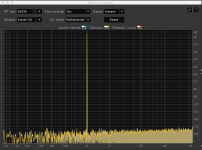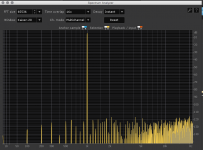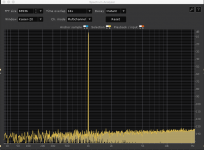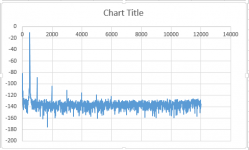.....So, I'd argue that no matter what you do you are really stuck at 14 or 15 bits. it is inherent to the R2R. ...
Given that the Soekris has been measured at -110dB and it uses the same R2R architecture as a PCM63 that also tests with a similar noise floor, I would suggest your argument that a noise floor of -90dB is an inherent R2R limit appears flawed. 🙂
Given that the Soekris has been measured at -110dB and it uses the same R2R architecture as a PCM63 that also tests with a similar noise floor, I would suggest your argument that a noise floor of -90dB is an inherent R2R limit appears flawed. 🙂
Noise floor isn't a worry on R2R. Nothing is wiggling on the inputs, which means you are just measuring the thermal noise of a resistor and whatever buffer opamps follow.
The concern with R2R is THD and THD+N. Since THD and THD+N are effectively the same at -84, that tells you that the harmonic distortion (not noise) are your limiting factor. In other words, the harmonic distortion is way above the noise on this dac.
Since we know that in this case the THD = THD+N = SINAD, we know the effective number of bits is right at 14 bits. (THD+N/6 = ENOB)
The PCM63 is about 12 dB better for THD+N, which means 16 effective bits. And on page 6 of the spec they tell you so. The PCM63 is also guaranteed monotonic, something you cannot guarantee with 0.01% resistors.
If the PCM63P has -96 dB THD+N, and the PCM63P claims to have 16-17 bits of effective resolution, and this DAC is 12 dB worse than the PCM63P, and each bit is worth 6 dB of THD+N, doesn't that tell you this DAC is 14-15 bits effective resolution?
Combine that with the worst-case analysis on the resistor tolerances (which you can do yourself), and you have several sources of info all saying the same thing.
The PCM63 is about 12 dB better for THD+N, which means 16 effective bits. And on page 6 of the spec they tell you so. The PCM63 is also guaranteed monotonic, something you cannot guarantee with 0.01% resistors.
And despite all that theorising the DAM1021 sounds a whole lot better than the PCM63P-Y based DAC it replaced.
It's a bit of bogus argument to cite PCM63P specs. The published figures were done using 997Hz sine test tone rather than the more usual 1000Hz sine tone. That makes a fairly substantial difference.
This shows the difference in distortion levels of test tone .wav files.
997Hz test file:
1000hz test file:
You can see why BB chose to use 997Hz.
Attachments
Last edited:
The published figures were done using 997Hz sine test tone rather than the more usual 1000Hz sine tone. That makes a fairly substantial difference.
My bad, test specs for THD were done at 991Hz.
Spectrum is virtually the same as 997Hz, so point still stands.
Attachments
It's a bit of bogus argument to cite PCM63P specs. The published figures were done using 997Hz sine test tone rather than the more usual 1000Hz sine tone. That makes a fairly substantial difference.
You can see why BB chose to use 997Hz.
Well, to choose a specific frequency is often to have a coherent measurement where the FFT Windows smearing can be skipped using "No FFT Window". 😀
BUT, your measurements and source wave(s) may do not have any noise dithered and this is the cause of the seen artifacts ...
Please state clearly: is this a PCM63 or measurements of the DAM? 😕
Currently there are STILL (not serious IMHO 😱) no given measurements (IM, THD) for the various resistor precisions ... and specially the IM, while used a dual ladder topology for +/- swing
Hp
Please state clearly: is this a PCM63 or measurements of the DAM? 😕
Hp
You'd be less confused if you had read my post.
This shows the difference in distortion levels of test tone .wav files.
analysis of test tone .wav files.... So neither the PCM63 or DAM.
# Had the DAM connected to laptop
# Did nothing towards DAM for 10 minutes
# DAM suddenly stopped output sound, did change song in SB, but still no sound
# DAM responded to enter giving new prompts
# Gave Exit command
# Had the "plop" noise and on screen:
# exit
I2
L044
V-20
# and sound came back. But now sounding as good as I had remembered it 24 hours earlier.
Is there some degeneration going on over time? Did the DAM "restart"+
//
# Did nothing towards DAM for 10 minutes
# DAM suddenly stopped output sound, did change song in SB, but still no sound
# DAM responded to enter giving new prompts
# Gave Exit command
# Had the "plop" noise and on screen:
# exit
I2
L044
V-20
# and sound came back. But now sounding as good as I had remembered it 24 hours earlier.
Is there some degeneration going on over time? Did the DAM "restart"+
//
You'd be less confused if you had read my post.
This shows the difference in distortion levels of test tone .wav files.
analysis of test tone .wav files.... So neither the PCM63 or DAM.
OK, just my 2 cents: your wave files do not look ready for serious measurements 😀
Hp
Happens to me from time to time also. Not very often.# Had the DAM connected to laptop
# Did nothing towards DAM for 10 minutes
# DAM suddenly stopped output sound, did change song in SB, but still no sound
# DAM responded to enter giving new prompts
# Gave Exit command
# Had the "plop" noise and on screen:
# exit
I2
L044
V-20
# and sound came back. But now sounding as good as I had remembered it 24 hours earlier.
Is there some degeneration going on over time? Did the DAM "restart"+
//
When I think of it, I think it has happended when I have been very triggerhappy changing songs with different bitrate and so on....
I assume it loads the firmware and filters again. You either have to to enter "exit" or do a poweroff/poweron.
Noise floor isn't a worry on R2R. Nothing is wiggling on the inputs, which means you are just measuring the thermal noise of a resistor and whatever buffer opamps follow.
The concern with R2R is THD and THD+N. Since THD and THD+N are effectively the same at -84, that tells you that the harmonic distortion (not noise) are your limiting factor. In other words, the harmonic distortion is way above the noise on this dac.
Since we know that in this case the THD = THD+N = SINAD, we know the effective number of bits is right at 14 bits. (THD+N/6 = ENOB)
The PCM63 is about 12 dB better for THD+N, which means 16 effective bits. And on page 6 of the spec they tell you so. The PCM63 is also guaranteed monotonic, something you cannot guarantee with 0.01% resistors.
If the PCM63P has -96 dB THD+N, and the PCM63P claims to have 16-17 bits of effective resolution, and this DAC is 12 dB worse than the PCM63P, and each bit is worth 6 dB of THD+N, doesn't that tell you this DAC is 14-15 bits effective resolution?
Combine that with the worst-case analysis on the resistor tolerances (which you can do yourself), and you have several sources of info all saying the same thing.
PCM63 and PCM1704 have 16-17 bit accuracy. They use 0.001% laser trimmed resistors in their (single) ladder network.
What you wrote is absolutely right, I wrote the same in several previous posts.
Seems noone would take in the right consideration the electronical/mathematical approach.
I suggest you to give up, as I gave up.
The post you link to notes 0.006% THD, and assuming dominated by harmonics (which is characteristic of R2R) that means THD+N is also 0.006%, which is -84 dB, and that means the the SINAD is -84 dB, which means effective number of bits (enob) is 14.
(...)
Note that a modern 12-bit DAC can achieve -85 dB THD (slightly better). See TI DAC8043, for example. That also suggests the DAC is functioning more in the 13-14 bit region. A modern sigma delta converter is sitting around THD+N of -115 dB, which is about 20 effective bits.
(...)
My point is that the error some wish to cancel is inherent in R2R. It's not a bad thing, necessarily.It may very well be what makes the sound appealing to some.
What you wrote is absolutely right, I wrote the same in several previous posts.
Seems noone would take in the right consideration the electronical/mathematical approach.
I suggest you to give up, as I gave up.
I think everybody gets it because its obvious. But what is the reason of this discussion? It was allready explained by Soren that reason of 28bit resolution of DAM ladder is just for keep THD at constant level with digital volume control.
I hope its also obvious to everybody that 24bit sample resolution is just a marketing joke because there is only a noisefloor recorded on the LSBs. We do not need it. It consumes unnecessairly GBs on our HDDs just to carry a noise.
I think there is a reason why many people prefer R2R over sigma delta DACs in spite of clearly worse THD dB's on a paper. It seems this is similar reason why some prefer tubes over transistors and please do not argue that pepole are those who likes to listen to THD.
Psychoacoustics explained many times that human ear "measures" other than electronic equipment (high sensivity to time related distortion rather than THD, higher sensivity to odd harmonics rather than even harmonics etc).
So please leave this monotonicity limit of 14,15 or 17bits because it not contribute anything to this thread, and it will not deprive sonic superiority of good R2R DACs over sigma deltas.
Last edited:
Doesn't the fact that all your math on 0.01% resistors say it's not possible; yet the measurements on the first post based on 0.05% resistors has exceeded all your calculations show something is working differently?
In any case, I'm not really hearing any difference in the increased THD of 16+dB and lower dynamic range (10+dB) versus a few ESS9018-based DACs (well based on the ESS specs sheet). With the fast developing filter work 🙂worship: Paul), I'm actually enjoying this DAC so much. Pity none of the other delta-sigma DACs allow so much flexibility.
@ramallo: Not familiar with that input board... but is the 3.3v line being supplied to the isolated 3.3v input? I don't think it sounds distorted but if that connection is loose the sound is a little "off" on my setup. You can also check if the board successfully updated if you enter uManager again. Does it say 0.9 for fpga? Make sure you're using the right send protocol Xmodem1K
In any case, I'm not really hearing any difference in the increased THD of 16+dB and lower dynamic range (10+dB) versus a few ESS9018-based DACs (well based on the ESS specs sheet). With the fast developing filter work 🙂worship: Paul), I'm actually enjoying this DAC so much. Pity none of the other delta-sigma DACs allow so much flexibility.
@ramallo: Not familiar with that input board... but is the 3.3v line being supplied to the isolated 3.3v input? I don't think it sounds distorted but if that connection is loose the sound is a little "off" on my setup. You can also check if the board successfully updated if you enter uManager again. Does it say 0.9 for fpga? Make sure you're using the right send protocol Xmodem1K
Last edited:
I think everybody gets it because its obvious.
I think the concept that the accuracy of R2R varies substantially between units is NOT obvious to most. Errors in the resistor network work in your favor or against you....always. And therefore some units will inherently have less accuracy than others. One R2R with 0.01% (of any brand) may achieve just 13 bit accuracy, while the next with the exact same parts may achieve 16 bit. Each build is a dice role.
Do you think that is already obvious to most? It certainly wasn't obvious to me before I went through the exercise years ago.
I think everybody gets it because its obvious..
Not so obvious.
The main question is if you know that you are getting a 13-14 bit accuracy dac (with 0.01% resistors), not R2R or sigma-delta dac.
Well, you are absolutely free to get a dac with such that accuracy, but is not so obvious that you prefer a 13-14 bit accuracy dac rather than a 16-17 bit dac, the PCM1704. That's an R2R dac, not a sigma-delta dac. And it's a sign magnitude DAC, not a two's complement dac. And it uses a single ladder network, not a double ladder. And network resistors and switches are imprinted in the same silicon wafer, that (typically) ensures better thermal stability.
Not so obvious.
HELP i think by mistake i sended 5-7v instead of 3.3v to the isolation of my dam1021-01 and now it is not locking from the usb (led flashes) locks only from the coax input. Is there something i can do or i sould send the board for repair. (Already sended a pm to soekris)
Any ideas?
Any ideas?
Doesn't the fact that all your math on 0.01% resistors say it's not possible; yet the measurements on the first post based on 0.05% resistors has exceeded all your calculations show something is working differently?
Let me clarify: The math I'm doing is on the MSbit only, and I'm only looking if it exceeds +/- 0.5 LSB or not.
With 0.01% resistors, you don't exceed 1 lsb error on a 16-bit converter 30% of the time. With 0.05% resistors, you don't exceed 1 lsb on a 16-bit converter 6% of the time. It's a numbers game. You can theoretically find a unit with 0.05% resistors that outperform a 0.01%. You just have to look at enough units.
I'd guess that every DAC manufacturer measured THD, THD+N, etc, on every unit they make. So, there should be mean and std dev numbers on a batch of units. The THD mean on 0.01% units should be better than 0.05% units. The stddev is probably 1-2 dB.
I mean, intuitively you MUST be getting a better DAC with 0.01% resistors versus 0.05%? Right? But why is it better? Why spend the extra money? The answer is THD. 0.01% resistors gets you an extra ~1.5 bits of resolution over 0.05% resistors.
Let me clarify: The math I'm doing is on the MSbit only, and I'm only looking if it exceeds +/- 0.5 LSB or not.
With 0.01% resistors, you don't exceed 1 lsb error on a 16-bit converter 30% of the time. With 0.05% resistors, you don't exceed 1 lsb on a 16-bit converter 6% of the time. It's a numbers game. You can theoretically find a unit with 0.05% resistors that outperform a 0.01%. You just have to look at enough units.
I'd guess that every DAC manufacturer measured THD, THD+N, etc, on every unit they make. So, there should be mean and std dev numbers on a batch of units. The THD mean on 0.01% units should be better than 0.05% units. The stddev is probably 1-2 dB.
I mean, intuitively you MUST be getting a better DAC with 0.01% resistors versus 0.05%? Right? But why is it better? Why spend the extra money? The answer is THD. 0.01% resistors gets you an extra ~1.5 bits of resolution over 0.05% resistors.
Don't get me wrong, I'm really glad you posted because I'm understanding more 😱 versus the previous few posts by Andrea previously which focused on SNR (which has been debunked a few times)
That said, isn't this more an industry wide problem? No one talks about DACs (or even architecture) by effective bits and accuracy. So what we know (from the first post) is that this DAC has 28-bits that (do something) but have a SNR of about 20~21 bits and right now (from your post) with an accuracy of about 14~16 bits (depending on the luck of the draw). So Andrea is saying this should be called a 14-bit DAC... but does the industry call the ESS9018 ~20-bit DAC because it's THD is about 120dB? And we're assuming here that there is audible data in all 24-bits?
Another question I have is that THD+N measurements of the chip DACs aren't directly comparable in a sense, no? You still need to add other parts to it (notably the output stage). Will that THD+N figure remain the same when other passive/active components come into the picture? The measurements in the first post include power supply + driver (i.e. it's something that can be used straight to the amp). So why are we comparing it in a vacuum?
Last edited:
ok maybe its obvious to me more than to everyone that 24bit PCM1704 has no 24bit monotonicity, 20bit PCM63 has no 20bit and ofcourse 28bit DAM has no incredible (and unnessesary!) 28bit because it is not possible to get such resistors tollerance even with lasser triming.
After your detailed technical explanation ScreamingLordByron, I think no one has any doubts that thing are different then that. I agree 100%.
The problem with market ready R2R DAC chips is that it is always current output DACs (voltage output are taken from internal OPAMP like in AD1865) so to achieve full performance you need to load it with almost zero impedance - opamp, some other transistors stages more or less sound affecting.
Secondly low DAC current output level require very low noise output stage if we do not want to mask LSBs with OS intristic noise..
DAM is voltage output DAC with pritty high voltage swing which can drive many amplifiers directly.
Now, what is the FINAL OUTPUT accuracy of PCM1704 DAC after output stage whatever it is?
There are many PCM1704 implementations on the market and in DIY world, but how many of theme can be compared to 0,01% resistor tollerance TotalDAC in term of sound quality? Why some would choose this $$$ 13-14bit DAC over relatively cheap PCM1704 DAC? DAM is not TotalDAC, but both of theme are 14bit effectively.
So Andrea, maybe it not so obvious but when you compare 14bit monotonicity DAM with most of 17bit monotonicity PCM1704 from the same price level and then from few times more expensive level you will have to answer yourself why this DAC worse on paper is such better in the air.
After your detailed technical explanation ScreamingLordByron, I think no one has any doubts that thing are different then that. I agree 100%.
The problem with market ready R2R DAC chips is that it is always current output DACs (voltage output are taken from internal OPAMP like in AD1865) so to achieve full performance you need to load it with almost zero impedance - opamp, some other transistors stages more or less sound affecting.
Secondly low DAC current output level require very low noise output stage if we do not want to mask LSBs with OS intristic noise..
DAM is voltage output DAC with pritty high voltage swing which can drive many amplifiers directly.
Now, what is the FINAL OUTPUT accuracy of PCM1704 DAC after output stage whatever it is?
There are many PCM1704 implementations on the market and in DIY world, but how many of theme can be compared to 0,01% resistor tollerance TotalDAC in term of sound quality? Why some would choose this $$$ 13-14bit DAC over relatively cheap PCM1704 DAC? DAM is not TotalDAC, but both of theme are 14bit effectively.
So Andrea, maybe it not so obvious but when you compare 14bit monotonicity DAM with most of 17bit monotonicity PCM1704 from the same price level and then from few times more expensive level you will have to answer yourself why this DAC worse on paper is such better in the air.
Don't get me wrong, I'm really glad you posted because I'm understanding more 😱 versus the previous few posts by Andrea previously which focused on SNR (which has been debunked a few times)
That said, isn't this more an industry wide problem? No one talks about DACs (or even architecture) by effective bits and accuracy. So what we know (from the first post) is that this DAC has 28-bits that (do something) but have a SNR of about 20~21 bits and right now (from your post) with an accuracy of about 14~16 bits (depending on the luck of the draw). So Andrea is saying this should be called a 14-bit DAC... but does the industry call the ESS9018 ~20-bit DAC because it's THD is about 120dB? And we're assuming here that there is audible data in all 24-bits?
I think DAC specs generally refer to the internal precision, and it's well understood that effective is less than the internal width. In some cases, it's marketing. But you sort through all that with the SNR, THD and THD+N specs.
The THD with R2R is somewhat unique, because it's related to gain errors that occur sometimes: That is, if a particular bit is on or not.
For example, in conventional DACs, the noise floor rises as you truncate the bit width. This is the well know quantization noise. But gain errors manifest differently. For example, in the attached plot, this is an fft of a sine with the lower half (that is, the portion below 0) multiplied by 0.9995. That is a very, very small change to the waveform, but look how far the harmonics came up from just a 0.05% gain error! That is a single gain error. now imagine you have a hundred sources of error, each one is 0.01%. If you are lucky, they cancel. But you won't always be lucky. And when they don't, you get the type of distortion shown in the plot.
Sigma Delta converters have their own host of problems, including idle tones, strange IMDs that can show up, etc.
Another question I have is that THD+N measurements of the chip DACs aren't directly comparable in a sense, no? You still need to add other parts to it (notably the output stage). Will that THD+N figure remain the same when other passive/active components come into the picture? The measurements in the first post include power supply + driver (i.e. it's something that can be used straight to the amp). So why are we comparing it in a vacuum?
Well designed output stages have vanishing small distortion. A good op amp today is -135 dB, which is much smaller than even a top of the line DAC. So, as far as line levels go, your line performance should be very, very close to your raw DAC performance level.
Attachments
Last edited:
- Home
- Vendor's Bazaar
- Reference DAC Module - Discrete R-2R Sign Magnitude 24 bit 384 KHz



